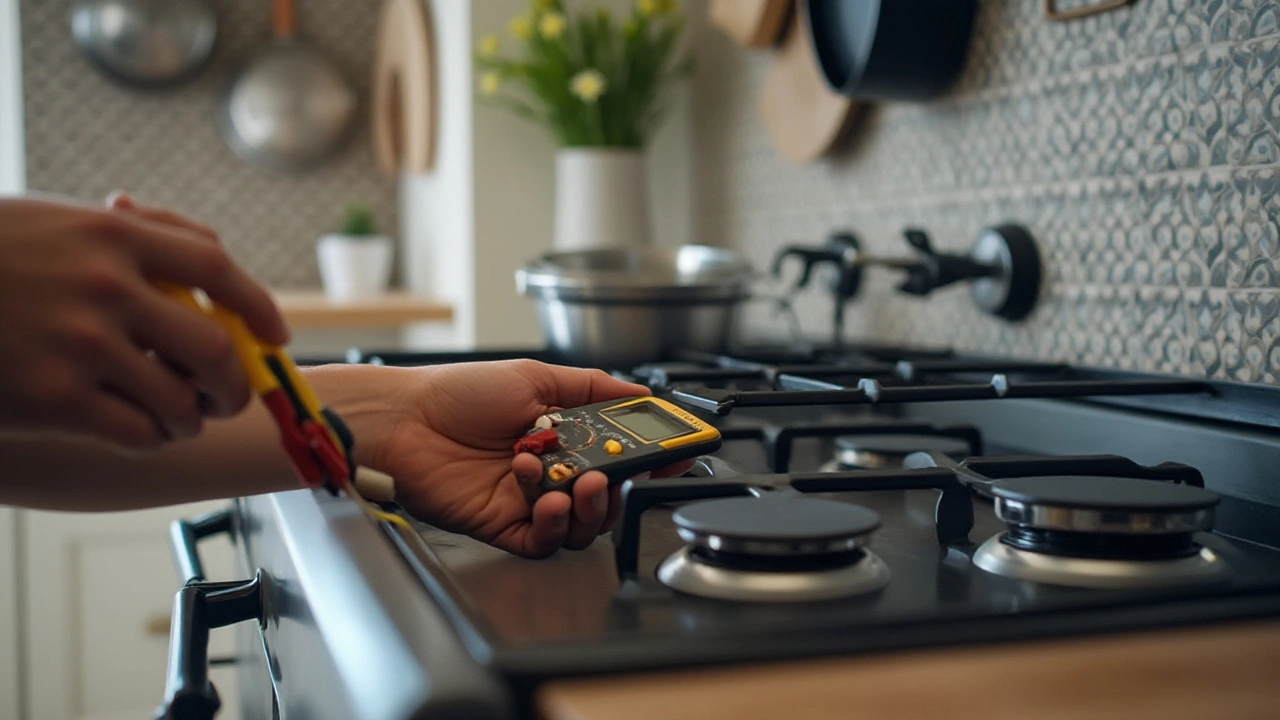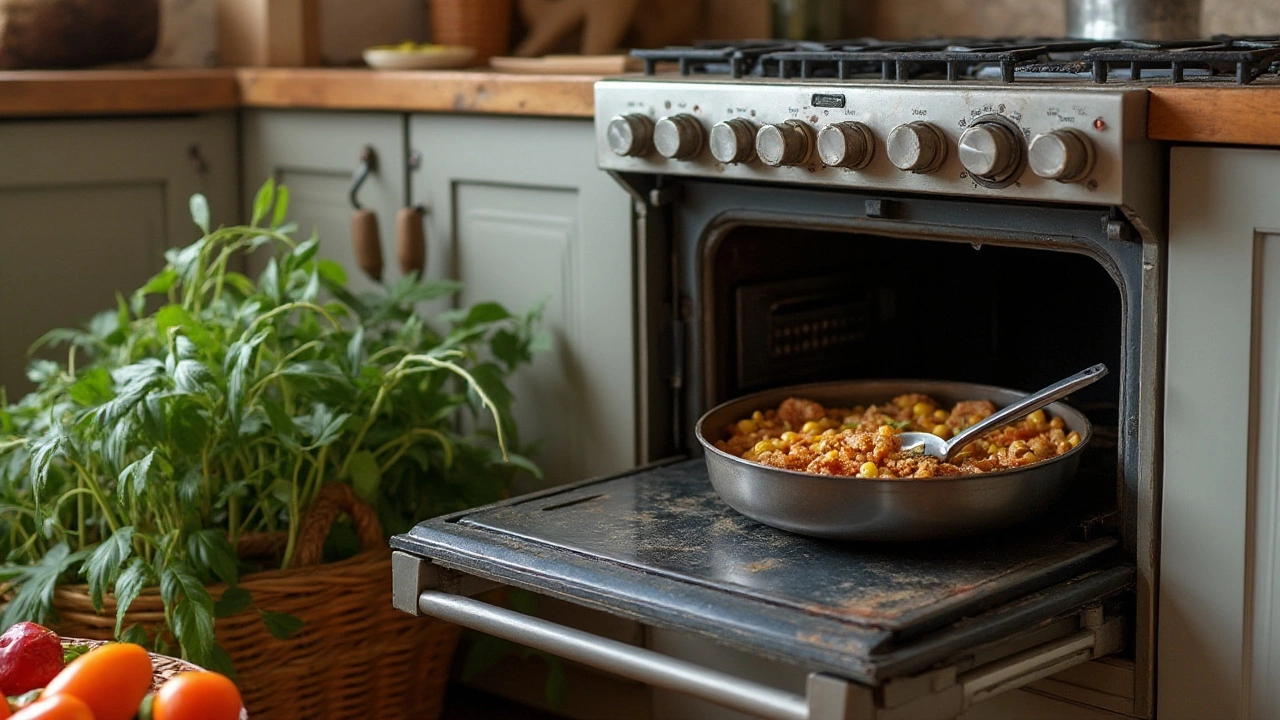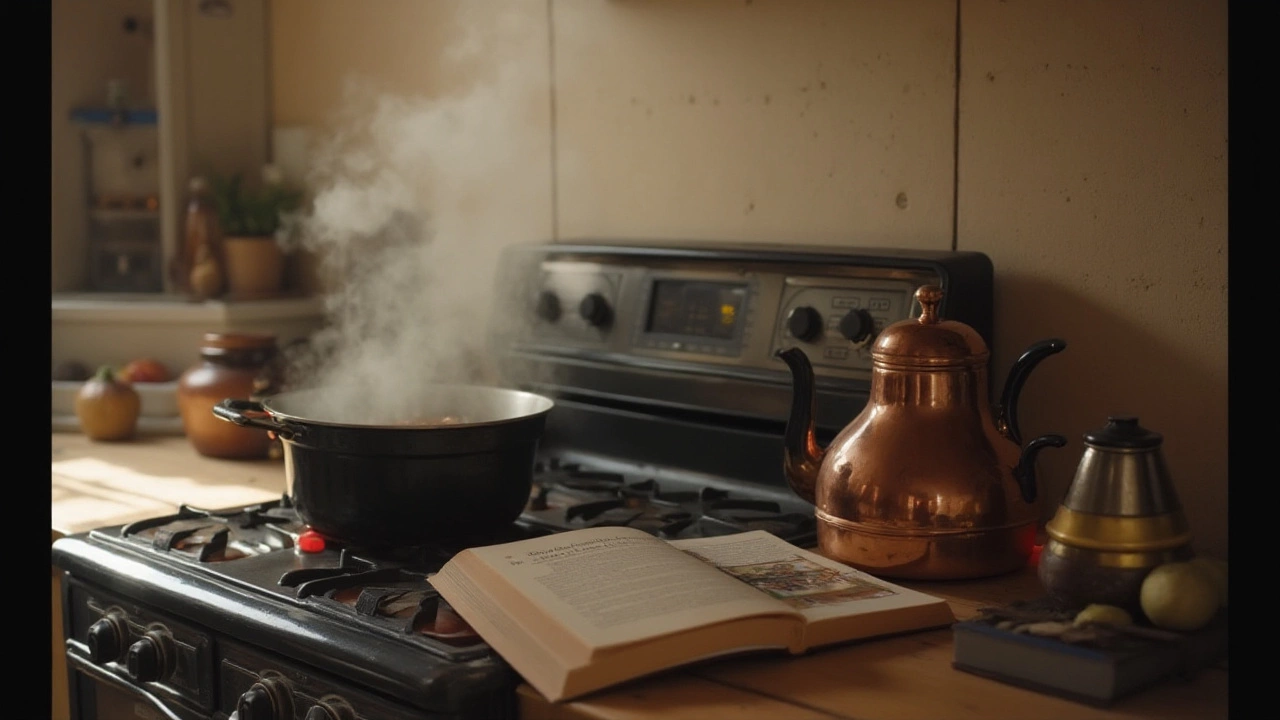Electric stoves have become indispensable in modern kitchens, providing efficient and reliable cooking solutions. Yet, even these stalwart appliances aren't immune to the occasional hiccup. Two issues often plague electric stove owners: the failure of the heating element and various wiring or connection complications.
These problems can not only disrupt your cooking routine but also lead to potential safety hazards. By gaining a better understanding of these common troubles, you can tackle them head-on, keeping your meals—and your peace of mind—intact.
- Introduction to Electric Stove Issues
- Problem 1: Malfunctioning Heating Element
- Tips for Handling Faulty Elements
- Problem 2: Wiring and Connection Troubles
- How to Address Wiring Issues
- Conclusion and Final Advice
Introduction to Electric Stove Issues
In the heart of every kitchen, the electric stove stands as a silent ally, converting ingredients into delicious meals with the turn of a dial. Like any appliance that sees daily use, electric stoves can develop problems over time. Knowing these issues in advance can prepare you for quick fixes or informed decisions if repairs become necessary. One of the most common problems is the malfunction of the heating element. These elements, much like the veins in a human body, are crucial for the stove's performance. When they falter, it's not just dinner plans that get disrupted—it can signal a deeper issue within the unit itself.
Another frequent issue is related to the stove's wiring and connections. Over time, connections can become loose, or wires can wear out, leading to inconsistent power flow. This is not just frustrating when you find your dish unevenly cooked; it can also pose safety concerns. Electric currents need clear, unimpeded pathways, and even a small fault in the wiring can lead to bigger problems. Thus, attending to these issues promptly isn’t just recommended—it’s essential.
The Silent Impact of Electric Stove Failure
While these problems might seem like mere inconveniences, they can affect the stove's efficiency and longevity significantly. According to a recent survey from Home Appliance Research, 65% of electric stove malfunctions reported annually are due to these two predominant issues. Such statistics underscore the importance of routine maintenance and a laid-back approach to understanding how your stove operates.Attending to signs of wear or failure can mean the difference between a simple DIY repair or calling in the professionals for complex repairs. Recognizing these symptoms early can save both time and expense. A laisse-faire approach might seem attractive now, but the cost of ignoring symptoms can escalate exponentially. Knowing your kitchen appliance, and how to care for it, is a valuable skill that pays dividends in culinary satisfaction and household safety.
"Understanding the source of a breakdown can often be less daunting than feared, and empowering if approached with the right knowledge," says Jane Smith, head of the Appliance Safety Board.
In the sections that follow, we'll delve deeper into the specifics of heating element failures and wiring issues, offering practical tips and insights into how to remedy these common glitches. Whether you are an experienced chef or someone who dabbles in cooking now and then, having a reliable oven is crucial for any culinary endeavor.
Problem 1: Malfunctioning Heating Element
When your electric stove starts misbehaving, one of the first suspects in the lineup is usually the malfunctioning heating element. These elements are the heart of your stove, built to withstand high temperatures and constant use. Yet, over time, wear and tear or a sudden mishap can lead them to fail. This can be frustrating and even alarming, especially when the time comes to prepare a meal, and the stove refuses to cooperate. Typically, a faulty heating element manifests itself by failing to heat up or only heating partially. In some cases, it may even cause irregular heating patterns, which can affect the cooking process, leaving meals unevenly cooked, with unexpected cold spots or burnt edges.
A deeper dive into why heating elements fail often reveals a mix of age, misuse, or manufacturing defects. The coils may develop breaks due to the constant expansion and contraction from heating and cooling. Cleaning practices using harsh chemicals or abrasive tools may damage the delicate surface of the elements, leading to their deterioration much faster. Another frequent issue is loose wiring or improper connections, which can not only affect heating but also pose a fire hazard. Switching off the stove at the first hint of a malfunction and investigating the problem can help in identifying if the heating element is indeed the root cause.
Replacing a heating element is not necessarily a daunting task. However, it requires some basic knowledge of your stove's anatomy and attention to safety, especially when dealing with electrical components. Homeowners are often advised to consult their stove's manual, which typically includes diagrams and instructions for DIY repairs. Yet, there are instances where it's best to reach out to a professional technician, particularly if rewiring is needed. The internet also offers a treasure trove of resources, from step-by-step tutorials to video guides that illustrate the replacement process for different stove models, making it easier for those willing to don the DIY hat.
"Home appliance experts often suggest periodic checks and cleaning to extend the longevity of your cooking components," notes Daniel Carey, a seasoned appliance repair technician. "Simple maintenance goes a long way in preventing the common pitfalls that lead to stove repairs."
For those who enjoy a more technical approach, using a multimeter to test for continuity in the heating element is a practical step. When performing this test, ensure the appliance is unplugged to avoid any accidental shocks or short circuits. If the multimeter doesn't show a reading, it's a clear indication that the element isn’t working correctly and needs replacement. Addressing these issues promptly not only saves on future repair costs but also ensures the kitchen appliance operates efficiently and safely.

Tips for Handling Faulty Elements
While working with an electric stove, one issue that many users encounter is a malfunctioning heating element. The heating element is the coil that gets red hot, glowing with the promise of a perfectly cooked meal. When it falters, though, meal prep can become a frustrating ordeal. The first step in handling a faulty heating element is understanding the signs of its failure. Often, the stove will take longer to heat up, or it might not reach the desired temperature at all. This could result in uneven cooking, leaving portions undercooked or overdone—a real headache when trying to whip up that perfect dinner. To determine if the heating element is truly at fault, a visual inspection can be helpful. A broken element might have visible damage, cracks, or it might not glow at all when switched on.
If you've identified a problematic element, replacing it can often solve the issue. Before you start, ensure the appliance is unplugged to prevent any electrical hazards. Most electric stove models come with removable heating elements, making replacement easier than you might think. Simply unplug the old element and plug in the new one. If you're unsure about the compatibility of a new element, consulting your stove’s manual can provide crucial insights. Alternatively, reaching out to the manufacturing company with your model number might help you confirm the right part. If you're not comfortable doing this yourself, hiring a professional is always a safe choice.
A practical tip when handling electric stove repairs is to keep a record of recurring problems. Tracking these can aid in pinpointing systemic issues early, potentially saving you a costly repair or replacement down the line. Regular maintenance is another proactive approach to keep your electric stove functioning optimally. Cleaning the elements and ensuring they are free of spills can extend their life.
According to Home Appliance Magazine, "Maintenance is the single most effective way to prolong appliance life."
While it might sound mundane, this advice underlines a key aspect of home appliance care. Even something as simple as regular dusting or ensuring the elements are dry before use can play a vital role. For those skeptical of tackling such tasks, remember that thorough guidance is often just an online search away. Numerous tutorials can walk you through the process of changing or cleaning elements, breaking it down into manageable steps for novices. In some cases, the issue with a heating element could also be an indicator of underlying electrical problems, such as faulty wiring. Consistently blown fuses or tripped circuit breakers can be a sign, often demanding more advanced expertise.
The process might seem daunting initially, but approaching it methodically makes all the difference. Whether you're an experienced DIY enthusiast or a first-timer, understanding the importance of the heating element in your electric stove will serve you well. Keep calm, take your time, and soon enough, your culinary space will be back in perfect working order, ready to conquer new culinary ventures.
Problem 2: Wiring and Connection Troubles
Delving into the world of electric stove issues, one often encounters the perplexing domain of wiring and connection troubles. Far from being just a tangled mess hidden behind your appliances, these electrical components play a critical role in ensuring your stove performs optimally. When wiring starts misbehaving, it often results in erratic or complete non-functionality of your cooking appliance.
Wiring problems might arise due to a variety of reasons. Over the years, wires can become brittle, leading to intermittent connections or complete disconnections. This can sometimes cause the stove to work one day and not the next, a classic sign of wiring woes. In more severe cases, faulty wiring could trip your circuit breaker, plunging your culinary escapades into darkness quite literally. To pinpoint the issue, a simple visual inspection might reveal wires that are worn out or burned. Older stoves are particularly susceptible to these problems, as materials degrade over time.
Connections, much like their wiring companions, can also be a source of headaches. If your stove features a digital interface, a faulty connection might make it unresponsive or cause it to display errors that you weren't expecting. Connections can become loose over time due to vibrations from regular use. Re-securing these connections can often restore function without the need for costly repairs.
"Electrical problems may lead to inefficiency and are often overlooked during regular appliance maintenance," notes Jane Thomas, a renowned home appliance expert.
Diagnosing and Fixing Wiring Problems
Identifying wiring issues involves a careful process. Safety should be your top priority, which means ensuring the appliance is disconnected from power before proceeding. Start by inspecting the termination points—these are the areas where wires connect to the stove. Loose or oxidized connections can usually be resolved with a simple brushing and re-tightening. But should you encounter damaged wires, they will likely require replacement.
When replacing wires, it's important to use wires of the appropriate gauge and type to match those originally used by the manufacturer. This is not just about ensuring function but also about maintaining safety. If you're not comfortable doing this, please consult a professional. Having an electrician review your stove’s wiring might cost a little extra, but it's worth ensuring that these complex electrical components are handled correctly and safely.
Preventing Future Issues
Preventative measures can go a long way in avoiding wiring and connection issues. Periodic checks, especially after moving the stove or if it’s been heavily used, can catch early signs of wear and tear. Additionally, consider the environment in which your stove operates. Kitchens with high humidity can exacerbate corrosion in electrical connections.
Regular maintenance isn’t just about peace of mind—it's about extending the life of your appliance and safeguarding every recipe you hope to create. By keeping wires and connections in check, you ensure that your electric stove remains a reliable tool in your culinary journey, turning raw ingredients into culinary masterpieces without a hitch.

How to Address Wiring Issues
Troubleshooting wiring problems in an electric stove might seem daunting at first glance, especially with those myriad wires weaving silently behind your appliance. However, by approaching the challenge methodically, you can often address issues without the need for a technician. The first step is safety. Always ensure the stove is unplugged to prevent accidents. Many electric stove wiring issues are due to either loose connections or burnt wires. To identify these problems, you need access to the stove's internal components. Gently pull the stove away from the wall, just enough to access the rear panel. Remove the screws securing the back panel using appropriate tools, and set the panel aside.
"Electric stoves, while convenient, require careful handling when diagnosing wiring issues. Always prioritize safety and call in a professional if you feel uncertain." - Better Home Guides
Once inside, look for signs of damage such as burnt marks or disconnected wires. Loose connections can often manifest as periods where the stove functions intermittently or with reduced capability. Tightening these connectors with a screwdriver could resolve the issue. Pay particular attention to areas where the heating elements connect to the main body of the stove. This is a common point for wires to loosen or burn due to heat exposure. If you notice any wires with burnt insulation or signs of melting, replacement is necessary. It is crucial to match the gauge and type of wire when purchasing replacements, maintaining the appliance’s safety and function.
Before you finish, consider testing the stove briefly. Reattach the back panel and plug the stove back in. Turn on your stove, and carefully observe its performance. If the symptoms persist, it might be wise to consider professional help. The expertise of a trained technician can ensure your stove’s electrical system is fully functional. Wiring and connection issues can not only prevent your stove from heating but also pose fire hazards if not addressed correctly. Therefore, understanding when a problem is beyond personal repair capabilities is vital. This approach balances do-it-yourself independence with the safety of professional oversight.
For those who like numbers, a study by Home Appliance Repair Association stated that approximately 12% of electric stove repairs annually are related to wiring failures. This statistic underscores the importance of regular maintenance checks and safe troubleshooting practices.
Conclusion and Final Advice
Dealing with issues related to your electric stove doesn’t have to be an overwhelming task. Whether you're tackling a broken heating element or deciphering a wiring puzzle, these problems are common and often come with straightforward solutions. With careful inspection and the right tools, you can approach these challenges with confidence.
Many times, addressing a malfunctioning heating element might be as simple as replacing a worn-out part. It's essential to familiarize yourself with your stove model and keep its manual handy, which often provides insights into common issues and their remedies. On the other hand, if you're dealing with wiring issues, it might be wise to consult a professional. Not only do they have the expertise, but they also ensure safety, especially when it comes to electrical components.
"Electrical issues can be complex and dangerous," says John Doe, an expert appliance repair technician. "It's crucial to know your limits and when to call in professionals to avoid unnecessary risks."
Taking proactive measures can also extend the life of your appliance. Regularly cleaning your stove and inspecting it for any signs of wear can save you a lot of trouble down the road. Proper maintenance not only prevents issues but also enhances its performance. Investing a little time now can prevent major headaches later on.
Remember, the key to longevity with any appliance is consistent care and being attentive to any unusual signs. If your kitchen appliance starts giving you trouble, don't delay the repairs. The sooner you address the issues, the easier they are to fix, often preventing bigger and more costly problems from arising. Stay informed, take care, and you’ll keep enjoying the culinary journey with less hassle and more delight.


